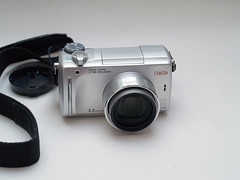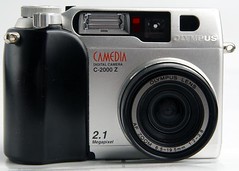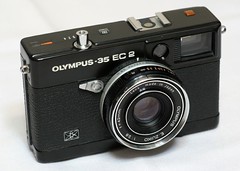Olympus
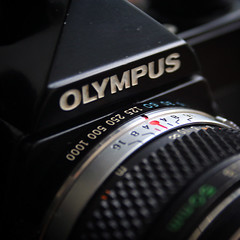
|
| Olympus logo on an OM-1. image by KF 红相机 (Image rights) |
Olympus is a Japanese company making cameras and other optical products.
Contents
History
Before the cameras

|
| Registration of the Olympus trademark (1920–21). Downloaded from the IPDL, in accordance to the IPDL policies. |
The company was founded on October 12, 1919 under the name K.K. Takachiho Seisakusho (㈱高千穂製作所, meaning Takachiho Works Co., Ltd.) by Yamashita Takeshi (山下長).[1][2] The address was Toyotama-gun Yoyohata-chō Hatagaya (豊多摩郡代々幡町幡ヶ谷) in Tokyo.[3][2] The founder was previously employed by Tokiwa Shōkai, which provided the financial support for the new company. The chief engineer was Terada Shintarō (寺田新太郎), who previously worked for M & Katera Kōgaku Kikai Seisakusho, and the first products of Takachiho Seisakusho were microscopes and thermometers.[1][2] At that time, Japan imported all its microscopes (and other instruments), mainly from Germany. The company had the clear ambition to rival, and even surpass, these high precision foreign imports. Olympus has been renowned to this day for its research on medical equipment.
The first microscope was released in early 1920, and was sold by Tokiwa Shōkai under its own Tokiwa brand.[4][2] The trade name Olympus was applied for on the same year 1920 and granted in early 1921.[5] The Olympus Tokyo logo was applied for in mid-1931 and registered a little later.[6] The company supplied microscopes to the Japanese Navy and became a "Navy approved factory" (海軍指定工場, kaigun shitei kōjō) in late 1933.[2] It offered an apparatus (the PM I) to take pictures with a microscope, consisting of a prism, a basic shutter and a dark-box taking a ground glass or 56×93mm glass plates,[7] and a similar device, the PM II, with a bellows instead of a rigid dark-box.[8]
First camera lenses
The company underwent research in camera lenses from about 1934, to diversify its activities.[9] In October 1935, a dependent company, called Mizuho Kōgaku Kenkyūjo (瑞穂光学研究所, meaning Mizuho Optical Research Institute), was set up for this purpose.[10] It was located in the same factory ground, and it was declared as a separate company only because of the rules for the allotment of electric energy.[11] The research on camera lenses was transferred to a new plant in Shibuya, Tagoto-chō in 1936.[12]
The company first tried to sell camera lenses alone.[13] Prototypes of a 105/4.5, a 75/4.5 and perhaps a 75/3.5 were assembled in mid 1936.[14] Their design was copied on the Tessar, with four elements in three groups, and their designer was Pr. Miyata (宮田尚一) under the supervision of Mr Suzuki (鈴木), chief of the optical department.[15] The name "Zuikō" (瑞光) was adopted after a contest open to the company employees;[16] it is a contraction of the first characters of "Mizuho Kōgaku".
First cameras
The company wanted to sell the lenses alone but did not find any client, so it decided to make a camera around them, under its own "Olympus" brand.[17][18] It is said that this was suggested to Takachiho officials by Miyazaki Shizuma (宮崎静馬), founder of Proud-sha, who offered to supply the camera bodies.[17] This is how Takachiho launched its first camera, a 4.5×6 folder called Semi Olympus, said to be released in September 1936.[19] The body was the same as the Semi Proud and the lens was the only part produced by Takachiho.
The company soon began to make its own Koho shutter and its own camera bodies. The bodies were made in the same Shibuya plant as the Zuiko lenses, and the shutters were made in the Hatagaya plant.[20] The Olympus Standard and the Semi Olympus II were the first cameras entirely made by Takachiho, whose prototypes were pictured in advertisements dated 1937.[21] The former, an ambitious project led by Sakurai Eiichi, was abandoned after ten prototypes were made; the latter, designed by Mr Kitakawa, was sold until 1940.[22]
It seems that the founder Yamashita Takeshi wanted to emulate the German company Carl Zeiss, which made microscopes and camera lenses, among the best of the time, and had entered camera production with the creation of Zeiss Ikon.[22] It is said that he already wanted to make cameras when he engaged Sakurai Eiichi in 1935.[23] The Tessar was chosen as a model for the Zuiko lens, and the Semi Olympus II and Olympus Standard were positioned as rivals of the Ikonta and Contax. However the company chose to develop its own camera designs instead of copying the German models, unlike most other Japanese companies of the time. In Sakurai's own words, "to make cameras the same as the others was not interesting".[24]
Wide aperture lenses
Back in autumn 1936, Takachiho received a subsidy of ¥9,000 to develop high aperture camera lenses from Japanese optical glass.[25] This money was invested in the purchase of optical instruments, including an Askania optical bench installed in 1937.[26] Three lens designs emerged from this research: the Zuiko 65/2.7 and Falcon 65/2 advertised in 1937 for the Olympus Standard, and the Olympar f/1.5, which would be produced as the Zuiko 50/1.5 and sold to Shimazu Seisakusho for X-ray cameras around 1940.[27]
1940–1945
The Olympus Six was launched in 1940 in 6×6 format. It was the first of a line of 6×6 folders that would last until about 1957 with the Olympus Chrome Six series. Some of these cameras received a five-element lens called S Zuiko.
Takachiho fell under the control of Ataka Shōkai (安宅商会) in 1939, and Chatani Yasusaburō (茶谷保三郎) became the CEO of the company, whereas Yamashita Takeshi resigned on the following year.[28] In 1942, the company name became Takachiho Kōgaku Kōgyō K.K. (高千穂光学工業㈱, meaning Takachiho Optical Industries Co., Ltd.).[29] Because of the war, dispersal plants were opened in Suwa (諏訪, 1943) and Ina (伊那, 1944), both in Nagano-ken (Central Japan).[30] The Shibuya plant was evacuated to Suwa, in a former textile factory.[31] The Hatagaya plant was not evacuated, and it was destroyed by an aerial bombing on May 25, 1945, with all the archives and the microscope production line.[32] The production line of the Koho shutter was also located in Hatagaya and was destroyed as well; this is why Olympus stopped the production of camera shutters for a number of years.[33]
After the war

|
| Logo 1953 image by Denny Narciso (Image rights) |
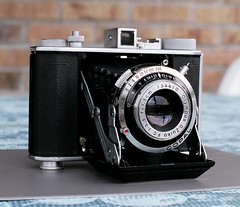
|
| Chrome Six III image courtesy M. Walters (Image rights) |
The production of the Olympus Six camera was resumed in early 1946 in the Suwa plant.[34] It is said that officials from Mamiya visited the Suwa plant on the same year, to sign contracts about the supply of Zuiko lenses for the Mamiya Six bodies.[35] In 1948 was launched the Olympus 35, a 35mm camera with a lens shutter, and the Olympus Chrome Six, an evolution of the Olympus Six with a diecast body. The company headquarters at the time were in the Shibuya plant, and the logo was the same OLYMPUS TOKYO as in the prewar period.[36] On January 1st, 1949[37] the company adopted the name Olympus Kōgaku Kōgyō K.K. (オリンパス光学工業㈱, meaning Olympus Optical Industrial Co., Ltd.); the official English name was Olympus Optical Co., Ltd. An OLYMPUS OIC logo was used for some time after that date, where "OIC" stands for Optical Industrial Company.[38] In the early 1950s, the headquarters moved back to Hatagaya, and the commercial department settled in Ginza.[39]
In the 1950s there was a TLR vogue in Japan, and Olympus followed the trend from 1952 to 1956 with the 6×6 Olympus Flex. In 1959, after the Rolleiflex Baby Grey had initiated a short revival of the 4×4 format, the company announced the Eye 44 auto-exposure TLR, but it remained at prototype level. During the same year 1959 Olympus launched the Pen half-frame camera, designed by Maitani Yoshihisa[40], the first of a long series. Its compactness and sleek lines were revolutionary at the time, and it could take 72 shots without reloading on a standard 35mm cassette. This time it was Olympus that was setting the trend, and after the Pen many other camera companies began to produce their own half-frame cameras. Olympus was the only one to make a half-frame SLR system, the Pen F, released in 1963. The Pen cameras are still popular today among enthusiasts.
Microscopy was still as important to Olympus as photography. The PM5 microscope camera was made in 1951, the PM6 in 1955, and the PM7 in 1964.[41] These all comprise a camera body with a tube coupling to the microscope, incorporating a shutter and a beam-splitter serving the side viewfinder. An exposure meter for the microscope cameras was available.
Trip, OM and XA
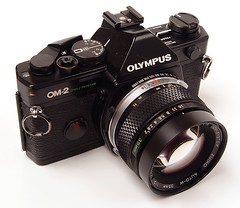
|
| OM-2 image by Martin Taylor (Image rights) |
1967 Olympus launched the Trip series, ingenious 35mm viewfinder cameras with automatic exposure thru lens-surrounding selenium meter. 10 millions were sold until 1984.
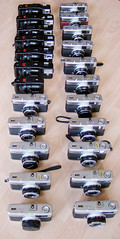
|
| Olympus XA and Trip 35 image by mikeasaurus (Image rights) |
1972 saw the launch of the OM 35mm SLR system. At a time when the large and relatively heavy Nikon F was still the workhorse of professional photographers, the compact OM system was once again revolutionary. The system incorporated a large line of highly-regarded Zuiko lenses, interchangeable focusing screens, winders and, later, advanced flash units. While never quite challenging Nikon and Canon as the leading choice of professional photographers, Olympus did have a loyal and dedicated following for the OM system, including David Bailey and Lord Lichfield. The OM system has also kept a good reputation among astronomers, macro and micro photographers; this is related to the company's involvement in medical and research equipment.
In 1978 Olympus launched its XA line of compact cameras. The XA is probably the smallest true rangefinder camera ever sold and was very popular among photographers as the pocket camera to carry.
Into the present
During the mid-to-late '80s Olympus lost ground to its competitors in the SLR field as autofocus took off. Research and development spending was focussed on high-selling compact point and shoots. Although the company did eventually release an autofocus SLR system it was not a serious challenge to Minolta, Nikon or Canon. Olympus changed its orientation and pioneered the concept of the "bridge" camera (an auto-everything SLR with fixed zoom lens) with the IS series. In the early '90s, Olympus had significant success with the compact autofocus Stylus (or µ[mju:] ) line. It carried on this success at the turn of the century into the digital field, as film camera production was ended in 2005. When the digital market took off with the launch of reasonably affordable, compact 2.3 megapixel cameras for consumers, there were only two real options for photographers — the Nikon Coolpix or the Olympus Camedia ranges. Before the availability of affordable (sub-$5k) digital SLRs, Olympus' E series of fixed-lens SLRs, evolved from the earlier analogue bridge cameras, was very popular among serious photographers.

|
| Olympus's milestones for the decade of analog photography's clinical death Left: 2003's Olympus E-1 marked the end of analog professional photography. Right: The first retro style digital system camera, the Pen E-P1 of 2009. image by maoby (Image rights) |
The launch of cheaper digital SLRs saw Olympus lose ground again among serious photographers, but in 2003 the E series was developed into an innovative interchangeable-lens SLR system. Without the huge autofocus lens catalogue of Nikon and Canon, Olympus was free to build its system without concessions to an older 35mm-based system. This way Olympus became the champion of the Four-Thirds system, a new conception of autofocus lens mount and minimal system sensor size , designed by Olympus and Panasonic, a system with smaller sensor rather than the APS-sized sensors Konica Minolta, Canon and Nikon put into their DSLR bodies, which are derived from 35mm film cameras. This allowed Olympus to design its bodies and lenses specifically for digital use. The first model of its Four-Thirds E-series of DSLRs was the Olympus E-1. It was the first professional model of the modern type compact DSLRs for interchangeable lenses. Olympus was slow in evolving its professional DSLR line but fast in delivery of new consumer DSLRs of its E-line.
Along with Panasonic, Olympus has also launched a compact camera system based on the Micro Four-Thirds standard, a Four-Thirds variant improved for CSC type digital system cameras. This newer standard has half the flange focal distance of the orignal Four-Thirds, 6mm smaller throat size, and enables making compact cameras with DSLR image quality. For this it revived its famous Olympus Pen brand. The new Pens are finderless compact digicams for Micro-Four-Thirds lenses, but including an accessory shoe where an electronic eye-level finder can be attached instead of a flash.
The company took its present name of Olympus Corporation (オリンパス株式会社) in 2003, and it continues to innovate and to challenge other manufacturers to do so by the incorporation of features such as 'Live-View', tilt/swivel LCDs and full user control over the noise filter on its 'E-System' range of DLSRs.
Revelations about the top management of Olympus made world headlines in late 2011, regarding accounting practices designed to disguise earlier losses.[42] As of February 2012, investigation continues into what is commonly referred to as a scandal, and has led to resignations and arrests of Olympus officials.[43] These events cast doubt over the future of the corporation's camera division (whose earnings had not matched those of the medical-products arm); yet new Olympus camera and lens introductions continue.
Take-over of camera-, lens- and accessory-production by OM
In early autumn 2020 Olympus sold its imaging business to JIP.[44] JIP itself founded OM which started in 2020 with a workforce of 2000 people, as it seems mainly to continue the production of some cameras and the M.ZUIKO lenses. The Olympus OM-D system cameras are the name-giving flagship product of OM. The brand name Olympus was used until mid 2022. Later products of OM are badged OM System.
Digital
| - |
Still-video (analog)
Digital point and shootDeltis series
Camedia series
|
FE / X series
SH series
SP series
SZ series
|
VG series
VR series
Others
|
Olympus Stylus / μ [mju] digital
for Olympus Stylus digital and μ [mju] digital see Olympus Stylus µ digital cameras
Tough series
For Stylus/µ WP, Stylus/µ water and Stylus/µTough see Olympus Stylus µ digital cameras
- Olympus TG-1 iHS (2012)
- Olympus TG-2 iHS (2013)
- Olympus TG-3 (2014)
- Olympus TG-4 (2015)
- Olympus TG-5 (2017)
- Olympus TG-6 (2019)
- Olympus TG-310 (2011)
- Olympus TG-320 (2012)
- Olympus TG-610 (2011)
- Olympus TG-630 iHS (2013)
- Olympus TG-810 (2011)
- Olympus TG-820 iHS (2012)
- Olympus TG-830 iHS (2013)
- Olympus TG-850 (2014)
- Olympus TG-860 (2015)
- Olympus TG-870 (2016)
DSLR (fixed zoom lens)
- Olympus C-1000L / D-500L
- Olympus C-2500L
- Olympus C-1400L / D-600L (1997)
- Olympus C-1400XL / D-620L (1998)
- Olympus E-10
- Olympus E-20
- Olympus E-100 RS (2000)
System cameras
Fixed zoom lens
- Olympus XZ-1
- Olympus XZ-2
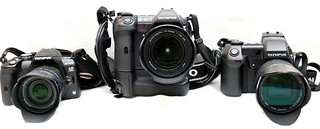
|
| image by idua_japan (Image rights) |
E-System: DSLRs (Four Thirds mount)
- Olympus E-1
- Olympus E-3
- Olympus E-30
- Olympus E-300 (EVOLT E-300)
- Olympus E-500 (EVOLT E-500)
- Olympus E-330 (EVOLT E-330)
- Olympus E-400
- Olympus E-410
- Olympus E-420
- Olympus E-450
- Olympus E-5
- Olympus E-510
- Olympus E-520
- Olympus E-620
PEN: MILCs (Micro Four Thirds mount)
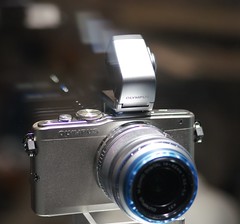
|
| image by Uwe Kulick (Image rights) |
- Olympus Pen E-P1 - 2009
- Olympus Pen E-P2 - 2010
- Olympus Pen E-P3 - 2011
- Olympus Pen E-P5 - 2013
- Olympus Pen E-P7 - 2021
- Olympus Pen E-PL1 - 2010
- Olympus Pen E-PL2 - 2011
- Olympus Pen E-PL3 - 2011
- Olympus Pen E-PL5 - 2012
- Olympus Pen E-PL6 - 2013
- Olympus Pen E-PL7 - 2014
- Olympus Pen E-PL8 - 2016
- Olympus Pen E-PL9 - 2018
- Olympus Pen E-PL10 - 2019
- Olympus Pen E-PM1 - 2011
- Olympus Pen E-PM2 - 2012
- Olympus Pen-F - 2016
OM-D: MILCs (Micro Four Thirds mount)
- Olympus OM-D E-M1 - 2013
- Olympus OM-D E-M1 Mark II - 2016
- Olumpus OM-D E-M1 Mark III - 2020
- Olympus OM-D E-M1X - 2019
- Olympus OM-D E-M5 - 2012
- Olympus OM-D E-M5 Mark II - 2015
- Olympus OM-D E-M5 Mark III - 2019
- Olympus OM-D E-M10 - 2014
- Olympus OM-D E-M10 Mark II - 2015
- Olympus OM-D E-M10 Mark III - 2017
- Olympus OM-D E-M10 Mark IIIs - 2020
- Olympus OM-D E-M10 Mark IV - 2020
AIR: MILC Hybrid (Micro Four Thirds mount)
- Olympus AIR A01 - 2015
35mm Full Frame
SLR
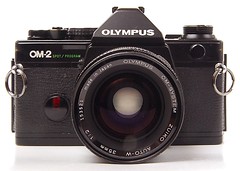
|
| image by Martin Taylor (Image rights) |
Olympus OM system, comprising:
- Olympus OM-X prototype camera
- Olympus M-1 (1972)
- Olympus OM-1 (1973–74)
- Olympus OM-1MD (1974–79)
- Olympus OM-1n (1979–87)
- Olympus OM-2 (1975–79)
- Olympus OM-2n (1979–84)
- Olympus OM-2SP / OM-2S (1984–88)
- Olympus OM-3 (1983–86)
- Olympus OM-3Ti / OM-3T (1995–2002)
- Olympus OM-4 (1983–87)
- Olympus OM-4Ti / OM-4T (1987–2002)
- Olympus OM-10 (1979–87)
- Olympus OM-10 Quartz (1980–87)
- Olympus OM-20 / OM-G (1983–87)
- Olympus OM-30 / OM-F (1983–87)
- Olympus OM-40 / OM-PC (1985–87)
- Olympus OM-707 / OM-77 (1986–91)
- Olympus OM-101 / OM-88 (1988–91)
- Olympus OM2000 (1997–)
- Olympus IS series
Fixed Lens
| ||
|
Fixed focus:
- Olympus XA 1 (1982)
- Olympus Trip Fixed Focus series (plastic-bodied 100, 400, Trip MD, 500, 600) (1984-2000)
- Olympus Shoot & Go, Shoot & Go R
Zone focus:
- Olympus 35 Series (Olympus 35 I/II/III/IV/IVa/IVb/Va/Vb)
- Olympus Wide (II)/E
- Olympus 35 EC, EC2
- Olympus Trip 35 (metal body, 1967-1984)
- Olympus XA 2, XA 3, XA 4 (1980–86)
Rangefinder:
- Olympus 35-S/K/S II
- Olympus Wide S
- Olympus Auto (B)
- Olympus Auto Eye (II)
- Olympus S/SC (Electro Set)
- Olympus 35 LE
- Olympus 35 LC
- Olympus ECR
- Olympus 35 ED
- Olympus 35 DC
- Olympus 35 RC
- Olympus 35 RD
- Olympus 35 SP, SPn and UC
- Olympus XA (1979)
Autofocus:
- Olympus 35 C-AF (Olympus' first autofocus compact)
- Olympus Accura/Superzoom series (80 Wide, 700BF, 130S WD etc.)
- Olympus AFL Quick Flash & AFL-S
- Olympus AFL-T
- Olympus AF series (AF-1, AF-10, AF-10 Super etc.)
- Olympus AM-100 (Infinity S).
- Olympus Écru (Limited edition with retro-styling)
- Olympus Infinity Twin
- Olympus Infinity AZ Super Zoom/IZM series (AZ-230, AZ-300, IZM400 etc)
- Olympus LT series (LT-1, LT zoom panorama)
- Olympus O-Product
- Olympus OZ series Japanese market versions of Infinity, Accura and Superzoom.
- Olympus mju Stylus Epic series (For μ[mju:], μ[mju:] II and III, Stylus/Epic and V)
- Olympus Trip (autofocus) series (plastic Trip AF MD etc.)
- Olympus Infinity Mini Weatherproof
Interchangeable Lens
- Olympus Ace and Olympus Ace-E
Microscope cameras
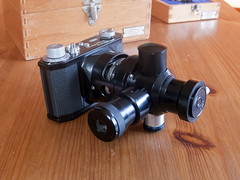
|
| Olympus PM-6 image by Henk van Zuylen (Image rights) |
- PM5 (1951)
- PM6 (1955)
- PM7 (1964)
- C-35DA-1 (1980s)
- C-35AD-4 (1980s)
- PM-6-8 (1980s)
- SC 35 (~1990)
16 mm
- SC16-3
- SC16-4
110 format
- SC16-10
35mm Half Frame
Olympus Pen series of compact cameras, comprising:

|
| Pen S image by Rick Soloway (Image rights) |
Fixed Lens
- original Pen (1959–60)
- Pen S 2.8 and 3.5 (1960–65)
- Pen W (1964–65)
- Pen D (1962–66)
- Pen D2 (1964–65)
- Pen D3 (1965–69)
- Pen EE and Pen EE (EL) (1961–68)
- Pen EE.S and Pen EE.S (EL) (1962–68)
- Pen Rapid EE.S (1965–66)
- Pen Rapid EE.D (1965–66)
- Pen EM (1965–66)
- Pen EE.D (1967–72)
- Pen EE.2 (1968–77)

|
| Olympus Pen FT image by Raúl Sá Dantas (Image rights) |
SLR
Olympus Pen F series of single lens reflex cameras, comprising:
120 film
4.5×6 folders
6×6 and 4.5×6 folders
- Olympus Six
- Super Olympus
- Olympus Chrome Six I and II
- Olympus Chrome Six III f/3.5 and f/2.8
- Olympus Chrome Six IVa and IVb
- Olympus Chrome Six V A and B
- Olympus Chrome Six RII A and B
TLR
- Olympus Flex I
- Olympus Flex BI
- Olympus Flex BII
- Olympus Flex A3.5
- Olympus Flex A2.8
- Olympus Flex A3.5 II
127 film
Interchangeable lens rangefinder
- Olympus Standard prototypes
TLR
- Olympus Eye 44 prototypes (f/3.5 and f/2.8)
126 film
APS film
- Olympus Centurion / Olympus Centurion S (SLR with fixed zoom lens)
- Olympus Newpic 100
- Olympus Newpic M10
- Olympus Newpic XB
- Olympus Newpic XB AF
- Olympus Newpic Zoom 600
- Olympus Newpic Zoom 90
- Olympus Newpic Zoom 60
- Olympus Newpic AF 200
- Olympus i-10
- Olympus i Zoom 60
- Olympus i Zoom 75
- Olympus i Zoom 2000
- Olympus i Zoom 3000
- Olympus i 100AF
- Olympus i snap
Lenses
Olympus traditionally brands all its lenses with the name Zuiko, a system begun with the very first Olympus camera released, and carried on throughout the various camera formats and systems since then. The company sold some Zuiko 7.5cm lenses to other camera manufacturers. It also made two lenses for a third-party lens mount in the early 1950s: the Zuiko 4cm f/2.8 for Leica and the Zuiko 4cm f/3.5 for Exakta.
Notes
- ↑ 1.0 1.1 Founding of Olympus at the Olympus official website.
- ↑ 2.0 2.1 2.2 2.3 2.4 Sakai, p.6 of Kurashikku Kamera Senka no.20.
- ↑ Trademark registration no.0125415, for the name "OLYMPUS" (オリンパス), available in the IPDL trademark database.
- ↑ The Olympus Logo History at the Olympus official website.
- ↑ Trademark registration no.0125415, for the name "OLYMPUS" (オリンパス), available in the IPDL trademark database. The trademark was registered for thermometers, microscopes, medical, chemical and optical instruments.
- ↑ Trademark documents available in the IPDL trademark database.
- ↑ Furuya, p.80 of Kurashikku Kamera Senka no.20.
- ↑ PM I and PM II photo-micrography accessories at the Olympus (archived).
- ↑ Date: Maitani, "Kamera-zukuri he no bōken"; Sakai, p.7 of Kurashikku Kamera Senka no.20; Francesch, p.19.
- ↑ Sakai, p.7 of Kurashikku Kamera Senka no.20. Francesch, p.20, says "Zuiho Optical Institute" but this is a mistake.
- ↑ Maitani, "Kamera-zukuri he no bōken".
- ↑ Date: Sakai, p.7 of Kurashikku Kamera Senka no.20. Tagoto-chō: Sakurai Eiichi, p.372 of Shashin Kōgyō no.78.
- ↑ Sakurai Eiichi, p.64 of Kurashikku Kamera Senka no.20. He does not specify if the company approached other camera makers or wholesale companies to sell the lenses to the general public, but the former is more likely.
- ↑ Hagiya mentions the 105/4.5 and the 75/4.5 on p.13 of Kurashikku Kamera Senka no.20. Sakai mentions the three models on p.7 of the same magazine.
- ↑ Pr. Miyata and Mr Suzuki: Sakurai Eiichi, p.64 of Kurashikku Kamera Senka no.20.
- ↑ Maitani, "Kamera-zukuri he no bōken"; Sakai, p.7 of Kurashikku Kamera Senka no.20; Francesch, p.19.
- ↑ 17.0 17.1 Sakurai Eiichi, p.64 of Kurashikku Kamera Senka no.20.
- ↑ Hagiya, p.13 of Kurashikku Kamera Senka no.20.
- ↑ Date: Sakai, p.7 of Kurashikku Kamera Senka no.20.
- ↑ Sakurai Eiichi, p.372 of Shashin Kōgyō no.78.
- ↑ Advertisement in Asahi Camera October 1937, reproduced in Kokusan kamera no rekishi, p.62, depicting a prototype of the Olympus Standard and an early Semi Olympus II with a Laurel shutter (predecessor of the Koho).
- ↑ 22.0 22.1 Sakurai Eiichi, p.65 of Kurashikku Kamera Senka no.20.
- ↑ Maitani and Sakurai, pp.65–6 of Kurashikku Kamera Senka no.20. Francesch, p.20, says that Sakurai participated in the tests of the Zuiko lens in 1936, but Sakurai himself said that his first commitment in the company before designing the Olympus Standard was the development of a revolving head for a microscope.
- ↑ Sakurai, p.65 of Kurashikku Kamera Senka no.20: "ほかのカメラと同じかっこうをしていたんじゃ面白くない。"
- ↑ Autumn 1936 and ¥9,000: Sakai, p.7 of Kurashikku Kamera Senka no.20. The date is given as 1937 in "Orinpasu kamera shisakuki 2-shu", p.59 of the same magazine. Japanese optical glass: Sakurai Eiichi, p.67 of the same magazine.
- ↑ Sakai, p.7 of Kurashikku Kamera Senka no.20, showing a picture of the Askania optical bench. The purchase of the Askania bench in 1937 is confirmed by Sakurai Eiichi, p.67 of the same magazine.
- ↑ Zuiko 65/2.7 and Falcon 65/2: advertisement for the Olympus Standard dated August 1937, reproduced in Kokusan kamera no rekishi, p.62. Falcon f/2, Olympar f/1.5, Zuiko 50/1.5 and Shimazu Seisakusho: Sakurai Eiichi, p.67 of Kurashikku Kamera Senka no.20.
- ↑ Sakai, p.7 of Kurashikku Kamera Senka no.20.
- ↑ See this page of the corporate website (archived). Same information in Francesch, p.26, Sakai, p.7 of Kurashikku Kamera Senka no.20.
- ↑ Francesch, p.26; Sakai, p.7 of Kurashikku Kamera Senka no.20. There is a picture of the Ina plant in this page of the corporate website (archived).
- ↑ Sakurai Eiichi, p.66 of Kurashikku Kamera Senka no.20; Francesch, p.26.
- ↑ Date: Sakai, p.7 of Kurashikku Kamera Senka no.20, says May 25; Francesch, pp.27–8, says April 26.
- ↑ Sakurai, p.372 of Shashin Kōgyō no.78; Francesch, p.28.
- ↑ Lewis, p.60, gives a month by month account of the production from January to July 1946.
- ↑ Francesch, p.28.
- ↑ Advertisements dated January 1948 to December 1950 reproduced in Kokusan kamera no rekishi, p.125. The exact address was Shibuya-ku Tagoto-chō 9 (渋谷区田毎町9).
- ↑ History page (archived) of the Olympus official website.
- ↑ Meaning of OIC: page of logos (archived) of the Olympus official website.
- ↑ Advertisements dated June 1952 to September 1955 reproduced in Kokusan kamera no rekishi, pp.126–30. The exact address of the headquarters (本社) was Shibuya-ku Hatagaya Haramachi 845 (渋谷区幡ヶ谷原町845). That of the commercial department (営業部) was Chūō-ku Ginza-nishi 6–5 (中央区銀座西6の5).
- ↑ The name is given in the Japanese order, with family name followed by the given name.
- ↑ Post-War microscope cameras PM5, PM6 and PM7 (archived) at Olympus.
- ↑ For a short summary, see Jake Adelstein, "Japan's Olympus scandal is slowly coming into focus", The Guardian, 3 November 2011. For a much longer one, see Karl Taro Greenfeld, "The silencing of Michael Woodford: The story behind the Olympus scandal", Bloomberg Business Week, 16 February 2012, a seven-part story starting here.
- ↑ See for example Juliette Garside, "Former Olympus chairman arrested as scandal deepens", The Guardian, 16 February 2012.
- ↑ dpreview about the takeover of Olympus' imaging branch by JIP
Bibliography
- Francesch, Dominique and Jean-Paul. Histoire de l'appareil photographique Olympus de 1936 à 1983. Paris: Dessain et Tolra, 1985. ISBN 2-249-27679-X.
- Furuya Bukichi (古谷武吉). "Orinpasu no kenbikyō" (オリンパスの顕微鏡, "Olympus microscopes"). Kamera Rebyū: Kurashikku Kamera Senka (カメラレビュー クラシックカメラ専科) / Camera Review: All about Historical Cameras no. 20, 25 March 1992. No ISBN number. Orinpasu no subete (オリンパスのすべて, special issue on Olympus). Pp.78–80.
- Hagiya Takeshi (萩谷剛). "Orinpasu kamera no subete 1: supuringu kamera <senzen-hen>" (オリンパスカメラのすべて1・スプリングカメラ戦前編, "All of Olympus cameras 1: folding cameras [prewar]"). Kamera Rebyū: Kurashikku Kamera Senka (カメラレビュー クラシックカメラ専科) / Camera Review: All about Historical Cameras no. 20, 25 March 1992. No ISBN number. Orinpasu no subete (オリンパスのすべて, special issue on Olympus). Pp.13–5.
- Lewis, Gordon, ed. The History of the Japanese Camera. Rochester, N.Y.: George Eastman House, International Museum of Photography & Film, 1991. ISBN 0-935398-17-1 (paper), 0-935398-16-3 (hard).
- Maitani Yoshihisa (米谷美久). "Kamera-zukuri he no bōken" (カメラ創りへの冒険, "Venturing into camera production"). Volume 1 of Haikei — Sekkeisha yori (拝啓・設計者より, "Dear Sir, from the designer"). Published in the Zuiko Club website, belonging to the Olympus Imaging Corp.
- "Orinpasu kamera shisakuki 2-shu" (オリンパスカメラ試作機2種, "Two experimental Olympus cameras"). Anonymous column about the Olympus Standard and Olympus Eye Flex. Kamera Rebyū: Kurashikku Kamera Senka (カメラレビュー クラシックカメラ専科) / Camera Review: All about Historical Cameras no. 20, 25 March 1992. No ISBN number. Orinpasu no subete (オリンパスのすべて, special issue on Olympus). P.59.
- Sakai Shūichi (酒井修一). "Orinpasu no rekishi" (オリンパスの歴史, "History of Olympus"). Kamera Rebyū: Kurashikku Kamera Senka (カメラレビュー クラシックカメラ専科) / Camera Review: All about Historical Cameras no. 20, 25 March 1992. No ISBN number. Orinpasu no subete (オリンパスのすべて, special issue on Olympus). Pp.6–9.
- Sakurai Eiichi (桜井栄一). "Orinpasu kamera no rekishi" (オリンパスカメラの歴史, "Brief History of Olympus cameras"). Shashin Kōgyō no.78 (October 1958). Pp.371–5.
- Trademark documents available in the IPDL trademark database:
- "OLYMPUS" (オリンパス), trademark applied for on 15 September 1920 and registered on 10 February 1921 (no.0125415);
- "OLYMPUS TOKYO" logo, trademark applied for on 2 June 1931 (no.S06-010000), published on 28 April 1932 (no.S07-002353) and registered on 8 August 1932 (no.0236083);
- "OLYMPUS TOKYO" logo, trademark applied for on 2 June 1931 (no.S06-010193), published on 27 September 1932 (no.S07-006799) and registered on 16 February 1933 (no.0240731);
- "OLYMPUS TOKYO" logo, trademark applied for on 2 June 1931 (no.S06-009999), published on 22 June 1933 (no.S08-005077) and registered on 4 October 1933 (no.0246957).
- "Zadankai: Orinpasu no michi" (座談会・オリンパスの道, "Conversation: the way of Olympus"). Interview of Sakurai Eiichi (桜井栄一), Maitani Yoshihisa (米谷美久) and Kawazoe Mitsuo (河添光男), by Saeki Kakugorō (佐伯恪五郎). Kamera Rebyū: Kurashikku Kamera Senka (カメラレビュー クラシックカメラ専科) / Camera Review: All about Historical Cameras no. 20, 25 March 1992. No ISBN number. Orinpasu no subete (オリンパスのすべて, special issue on Olympus). Pp.64–71.
Links
In English:
- Olympus and OM product history on om-digitalsolutions.com [1]
- History pages in the Olympus corporate site
- Olympus on the English Wikipedia.
- Olympus resource page — online repair manuals.
- Olympus film instruction manuals at Orphan Cameras (including the Olympus Pen, and a few "point and shoot" models).
- Olympus Cameras Price Guide - Full list of cameras, their photos, descriptions, and completed auction prices.
- Olympus total revenue 2007-2012
In French:
In Japanese:
- Olympus Spirit, a series of articles written by Maitani Yoshihisa, in the Zuiko Club website (archived)
- Olympus history pages at the Olympus Photo Club website:
In German:
- Olypedia wiki
- The unofficial Olympus User Forum — German.
